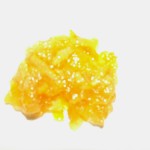After the windfall of free fruit, this week has seen Casa Dirty Boots become a hive of citrus preserving activity. We’ve juiced, pickled, preserved and marmaladed. Soon cordial and limoncello (and maybe even orange-cello) are on the menu. The house smells divine – lots of bubbling citrus and I have to say I’ve learnt a lot about marmalade.
 We’ve made marmalade many times over the years but this time I’ve gone research crazy and tried a few different techniques to see how different the taste can be depending on the method. Most methods require two or more hours cooking before you even add any sugar. Others ask you to juice then de-membrane the fruit before chopping. That is not a fun way to spend an afternoon – but I did it in the interests of scientific research!
We’ve made marmalade many times over the years but this time I’ve gone research crazy and tried a few different techniques to see how different the taste can be depending on the method. Most methods require two or more hours cooking before you even add any sugar. Others ask you to juice then de-membrane the fruit before chopping. That is not a fun way to spend an afternoon – but I did it in the interests of scientific research!
After yesterday’s brunch time taste test I can now, categorically state you can make marmalade which doesn’t use masses of energy or time to cook AND doesn’t involve too much hard work on your part. Our lowest energy (of both the gas and human sort) marmalade actually came tops in the DirtyBoots taste test. So if you’d like to make a more energy efficient marmalade here’s the recipe:
Homemade Low Energy Marmalade
- 1kg Seville, Temple or other sharp oranges (cleaned of dust and any wax coating)
- 2 lemons (similarly cleaned)
- 2 litres water
- 1.5kg white sugar
Halve and then slice all the fruit thinly. Reserve all pips and tie into a muslin bag. Put the fruit and bag of pips into a glass bowl and cover with the water. Leave overnight.
The following day transfer the fruit and water into your chosen preserving pan and bring to the boil. Now reduce the heat and simmer for 45 minutes to an hour till the rind is just soft and the mixture has reduced down by half.
Now add the sugar to the pan and slowly bring back to the boil, stirring to dissolve all the sugar.
Boil the mixture rapidly for 10-15 minutes till setting point is reached. To test for set drop a teaspoon of the mixture onto a cold plate and cool quickly. If the top wrinkles when you push it with your finger it is ready. Allow the mixture to cool for a few minutes and remove any scum with a slotted spoon.
Ladle into warm sterilised jars and seal.
The marmalade is good to eat immediately but will keep (sealed) for up to two years. The yield will be about 2kg – for us that was four large jars worth. It is best to make marmalade and jams in quantities no larger than this to ensure the mixture will reach its setting point temperature.
 Variations
Variations
We have made a St Clements version which is pretty zingy. Use 500g tart oranges, 500g sweet oranges and 4 lemons. The pith of sweet oranges remains opaque (that of sour fruit turns translucent) so the official line is that you remove all the membranes and pithy bits from the fruit before cooking. Unless you’re entering a competition or trying to sell the stuff please don’t waste your time.
We’ve also made a Coriander version. 3tbsp of freshly ground coriander seeds were added along with the sugar.
Finally we’ve done a Whiskey version too where 4tbsp of whiskey are stirred in once setting pointing has been achieved.
I have to say, personally that marmalade is such a strong tasting thing anyway that I don’t really feel the additional flavours of spices or booze add very much. But its all a matter of taste.
I am totally converted to this energy efficient method though. The overnight soaking means the fruit softens in less than half the time’s cooking. Best of all you don’t have to waste your own time juicing and then removing pith from the fruit. So even better still (for MrDB at least) there’s less washing up.
For a more self sufficient future
Thanks for this recipe. Anything that saves time and energy is a winner in my books.
🙂
Jeni Treehugger’s last blog post..Earth Hour 2009